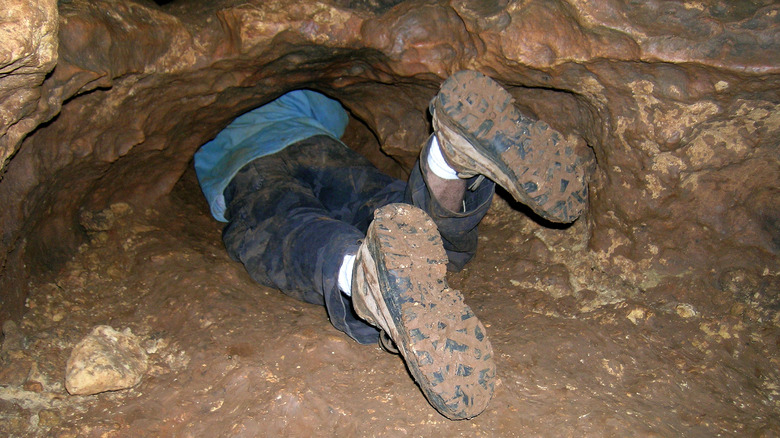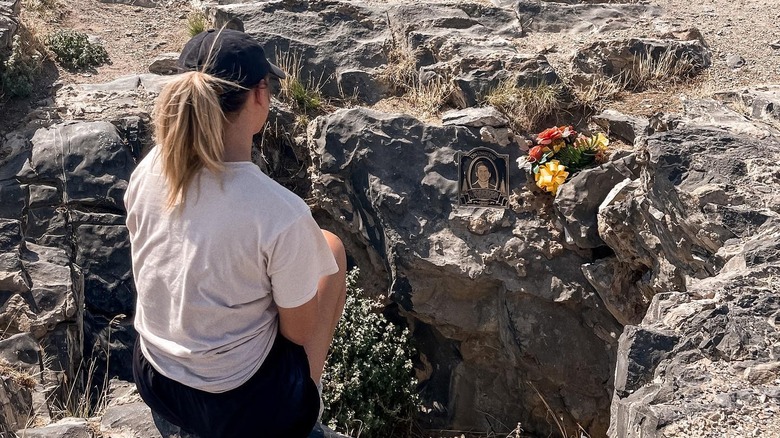The Tragic Reason Nutty Putty Cave Is No Longer A Hotspot For Spelunkers And Tourists
The story of Nutty Putty Cave goes that in 1960 a rancher noticed warm vapors emitting from an opening on Blowhole Hill, 63 miles south of Salt Lake City. The rancher knew Dale Green, a man who enjoyed exploring caves. Green and his friends ventured inside, discovering a network of narrow caves and tunnels. Some sections were lined with soft brown clay, prompting Green to nickname it Silly Putty Cave after the gooey toy that became popular with kids in the 1950s. That moniker didn't quite work, so it became known as Nutty Putty Cave instead.
In later years, Dale Green admitted that he wasn't too impressed by his discovery at first: "It didn't really have anything pretty in it. And there aren't a lot of places where you can stand up, so you're just pretty much crawling around all the time and you get all muddy."
Nevertheless, Nutty Putty Cave became one of the most popular spots in Utah for spelunkers, amateur cavers, Boy Scout troops, and locals horsing around in almost 1,400 feet of chutes, squeezes, and passageways. At the height of its popularity, anywhere between 5,000 and 10,000 people a year were heading into Nutty Putty for a taste of adventure in this unusual tourist attraction. According to Dale Green, it even had a reputation as a "date cave," due to students from nearby Brigham Young University taking their dates there. But with so many people visiting, it was only a matter of time before tragedy struck.
What was so interesting about Nutty Putty Cave?
The most beautiful caves in the world are formed in limestone, gradually eroded by lightly acidic water seeping downwards over thousands of years, eventually carving out whole cave systems. What is unusual about Nutty Putty Cave is that the process started from the bottom with water working its way up instead. This is known as a hypogenic cave, formed by hydrothermal activity deep underground. Water gets heated and forced upwards, and minerals in the water gradually dissolve the rock and create a sprawling network of shafts and tunnels. Typically, hypogenic caves have plenty of narrow squeezes and tight twists and turns, which is exactly what Nutty Putty was famous for. Some of its narrowest gaps earned nicknames like "Scout Eater" and "Birth Canal."
Then there is the strange clay that gave Nutty Putty Cave its name. The viscous substance was observed to leak out of the walls in some sections, with the strange property of turning from a solid matter into a sticky liquid when pressed. The clay is even sensitive to sound, moving or dripping if you shout at it.
Despite the tightness of some of the cave's sections, Nutty Putty was still regarded as an easy system to explore. Richard Downey, treasurer and historian of Timpanogos Grotto, a society that once managed the cave, "It was believed to be really easy and that's why all of your Boy Scouts and locals went in with flashlights and sandals and things."
The tragedy that sealed Nutty Putty Cave forever
Despite its friendly name and benign reputation, Nutty Putty Cave had its dangers and several explorers required rescuing over the years. In July 1999, two teenagers were pulled out after getting stuck in a narrow section for around 12 hours. Five years later, a 16-year-old boy got wedged upside down and needed an all-night rescue operation to free him.
The increase in visitors and rescue calls, combined with a fatal incident where four young people drowned in a cave in nearby Y Mountain, led to Nutty Putty being shuttered in 2006 due to safety concerns. It was reopened in May 2009 under the management of Timpanogos Grotto, who set up an online reservation system for groups wishing to explore the cave and ensured that the entrance was locked overnight. Even with these precautions, Nutty Putty's first fatality occurred six months later. 26-year-old John Edward Jones ventured into an uncharted section of the cave and found himself helplessly stuck upside down in a narrow crevice. Rescue attempts involving 137 volunteers desperately tried to extricate him for around 27 hours, but Jones sadly passed away.
In the wake of Jones' tragic death, it was determined that his body couldn't be safely recovered and the cave was sealed. It remains permanently closed and now all there is to visit on Blowhole Hill (now called John Jones Hill) is a plaque commemorating the unfortunate spelunker entombed within. Here's what to know before planning a spelunking expedition to stay safe.


